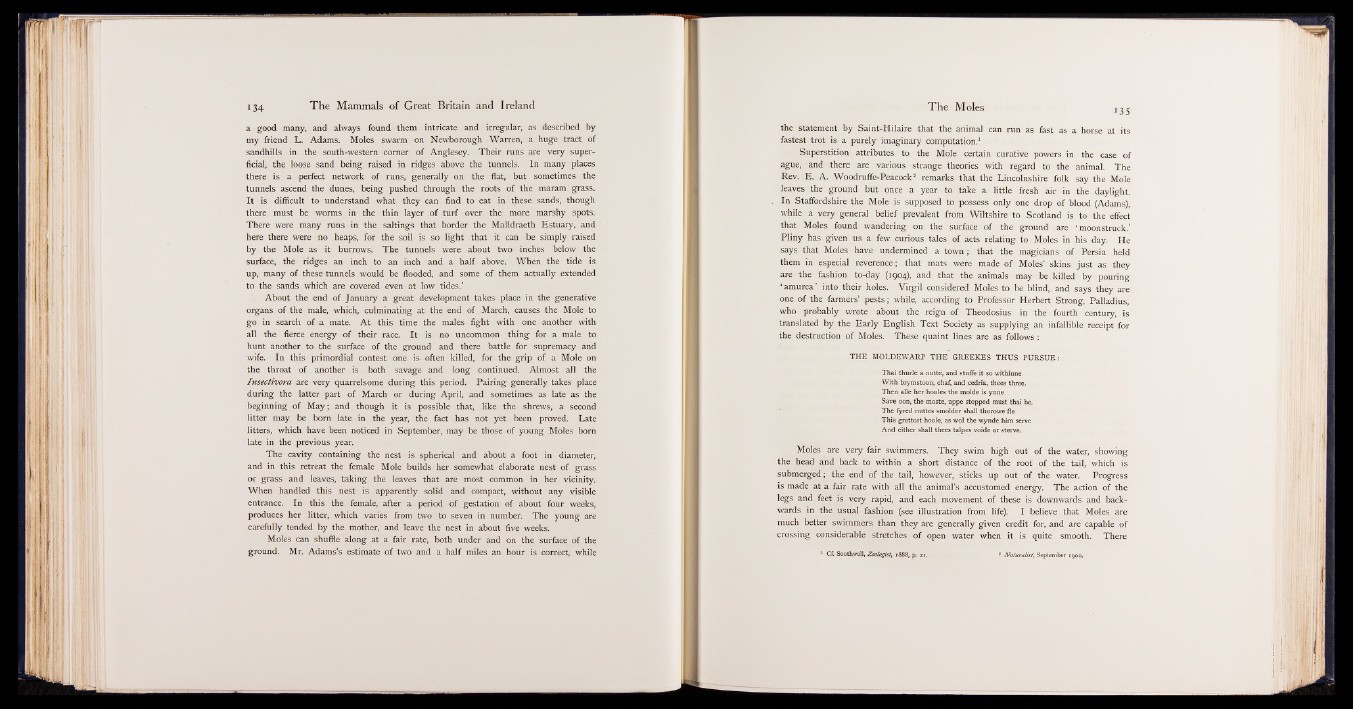
a good many, and always found them intricate and irregular, as described by
my friend L. Adams. Moles swarm on Newborough Warren, a huge tract of
sandhills in the south-western corner of Anglesey. Their runs are very superficial,
the loose sand being raised in ridges above the tunnels. In many places
there is a perfect network of runs, generally on the flat, but sometimes the
tunnels ascend the dunes, being pushed through the roots of the maram grass.
It is difficult to understand what they can find to eat in these sands, though
there must be worms in the thin layer of turf over the more marshy spots.
There were many runs in the saltings that border the Malldraeth Estuary, and
here there were no heaps, for the soil is so light that it can be simply raised
by the Mole as it burrows. The tunnels were about two inches below the
surface, the ridges an inch to an inch and a half above. When the tide is
up, many of these tunnels would be flooded, and some of them actually extended
to the sands which are covered even at low tides.’
About the end of January a great development takes place in the generative
organs of the male, which, culminating at the end of March, causes the Mole to
go in search of a mate. At this time the males fight with one another with
all the fierce energy of their race. It is no uncommon thing for a male to
hunt another to the surface of the ground and there battle for supremacy and
wife. In this primordial contest one is often killed, for the grip of a Mole on
the throat of another is both savage and long continued. Almost all the
Insectivora are very quarrelsome during this period. Pairing generally takes place
during the latter part of March or during April, and sometimes as late as the
beginning of May; and though it is possible that, like the shrews, a second
litter may be born late in the year, the fact has not yet been proved. Late
litters, which have been noticed in September, may be those of young Moles born
late in the previous year.
The cavity containing the nest is spherical and about a foot in diameter,
and in this retreat the female Mole builds her somewhat elaborate nest of grass
or grass and leaves, taking the leaves that are most common in her vicinity.
When handled this nest is apparently solid and compact, without any visible
entrance. In this the female, after a period of gestation of about four weeks,
produces her litter, which varies from two to seven in number. The young are
carefully tended by the mother, and leave the nest in about five weeks.
Moles can shuffle along at a fair rate, both under and on the surface of the
ground. Mr. Adams’s estimate of two and a half miles an hour is correct, while
the statement by Saint-Hilaire that the animal can run as fast as a horse at its
fastest trot is a purely imaginary computation.1
Superstition attributes to the Mole certain curative powers in the case of
ague, and there are various strange theories with regard to the animal. The
Rev. E. A. Woodruffe-Peacock2 remarks that the Lincolnshire folk say the Mole
leaves the ground but once a year to take a little fresh air in the daylight.
In Staffordshire the Mole is supposed to possess only one drop of blood (Adams),
while a very general belief prevalent from Wiltshire to Scotland is to the effect
that Moles found wandering on the surface of the ground are ‘moonstruck.’
Pliny has given us a few curious tales of acts relating to Moles in his day. He
says that Moles have undermined a town; that the magicians of Persia held
them in especial reverence; that mats were made of Moles’ skins just as they
are the fashion to-day (1904), and that the animals may be killed by pouring
‘ amurca’ into their holes. Virgil considered Moles to be blind, and says they are
one of the farmers’ pests; while, according to Professor Herbert Strong, Palladius,
who probably wrote about the reign of Theodosius in the fourth century, is
translated by the Early English Text Society as supplying an infallible receipt for
the destruction of Moles. These quaint lines are as follows:
TH E M O LD EW A RP TH E G R E E K E S TH U S P U R SU E :
Thai thurle a nutte, and stuffe it so withinne
With brymstoon, chaf, and cedria, thees three.
Then alle her hooles the molde is ynne
Save oon, the moste, uppe stopped must thai be.
The fyred nuttes smolder shall thorowe fle
This grettest hoole, as wol the wynde him serve
And either shall thees talpes voide or sterve.
Moles are very fair swimmers. They swim high out of the water, showing
the head and back to within a short distance of the root of the tail, which is
submerged; the end of the tail, however, sticks up out of the water. Progress
is made at a fair rate with all the animal’s accustomed energy. The action of the
legs and feet is very rapid, and each movement of these is downwards and backwards
in the usual fashion (see illustration from life). I believe that Moles are
much better swimmers than they are generally given credit for, and are capable of
crossing considerable stretches of open water when it is quite smooth. There
Cf. Southwell, Zoologist, 1888, p. 21. 2 Naturalist, September 1900.